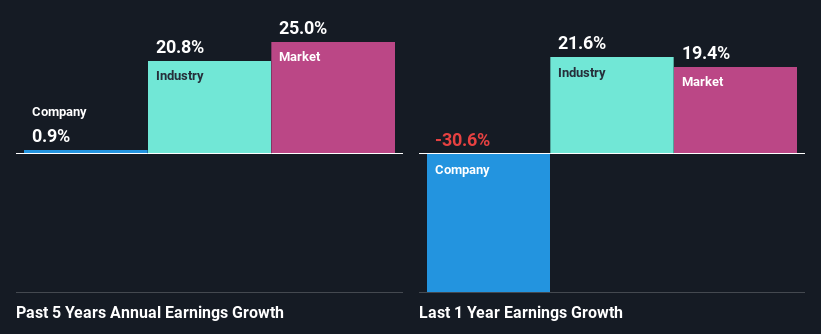Are Trident Limited's (NSE:TRIDENT) Mixed Financials Driving The Negative Sentiment?

Trident (NSE:TRIDENT) has had a rough three months with its share price down 18%. We, however decided to study the company's financials to determine if they have got anything to do with the price decline. Fundamentals usually dictate market outcomes so it makes sense to study the company's financials. Specifically, we decided to study Trident's ROE in this article.
Return on equity or ROE is an important factor to be considered by a shareholder because it tells them how effectively their capital is being reinvested. In short, ROE shows the profit each dollar generates with respect to its shareholder investments.
Check out our latest analysis for Trident
How Is ROE Calculated?
The formula for ROE is:
Return on Equity = Net Profit (from continuing operations) ÷ Shareholders' Equity
So, based on the above formula, the ROE for Trident is:
6.9% = ₹3.0b ÷ ₹43b (Based on the trailing twelve months to December 2024).
The 'return' is the yearly profit. One way to conceptualize this is that for each ₹1 of shareholders' capital it has, the company made ₹0.07 in profit.
What Has ROE Got To Do With Earnings Growth?
We have already established that ROE serves as an efficient profit-generating gauge for a company's future earnings. Depending on how much of these profits the company reinvests or "retains", and how effectively it does so, we are then able to assess a company’s earnings growth potential. Assuming all else is equal, companies that have both a higher return on equity and higher profit retention are usually the ones that have a higher growth rate when compared to companies that don't have the same features.
Trident's Earnings Growth And 6.9% ROE
It is quite clear that Trident's ROE is rather low. Even when compared to the industry average of 8.9%, the ROE figure is pretty disappointing. As a result, Trident's flat earnings over the past five years doesn't come as a surprise given its lower ROE.
As a next step, we compared Trident's net income growth with the industry and were disappointed to see that the company's growth is lower than the industry average growth of 21% in the same period.

The basis for attaching value to a company is, to a great extent, tied to its earnings growth. It’s important for an investor to know whether the market has priced in the company's expected earnings growth (or decline). This then helps them determine if the stock is placed for a bright or bleak future. If you're wondering about Trident's's valuation, check out this gauge of its price-to-earnings ratio, as compared to its industry.
Is Trident Making Efficient Use Of Its Profits?
Despite having a moderate three-year median payout ratio of 44% (meaning the company retains56% of profits) in the last three-year period, Trident's earnings growth was more or les flat. So there could be some other explanation in that regard. For instance, the company's business may be deteriorating.
In addition, Trident has been paying dividends over a period of at least ten years suggesting that keeping up dividend payments is way more important to the management even if it comes at the cost of business growth. Upon studying the latest analysts' consensus data, we found that the company's future payout ratio is expected to drop to 7.3% over the next three years. As a result, the expected drop in Trident's payout ratio explains the anticipated rise in the company's future ROE to 13%, over the same period.
Conclusion
In total, we're a bit ambivalent about Trident's performance. While the company does have a high rate of reinvestment, the low ROE means that all that reinvestment is not reaping any benefit to its investors, and moreover, its having a negative impact on the earnings growth. Having said that, looking at the current analyst estimates, we found that the company's earnings are expected to gain momentum. To know more about the latest analysts predictions for the company, check out this visualization of analyst forecasts for the company.
Valuation is complex, but we're here to simplify it.
Discover if Trident might be undervalued or overvalued with our detailed analysis, featuring fair value estimates, potential risks, dividends, insider trades, and its financial condition.
Access Free AnalysisHave feedback on this article? Concerned about the content? Get in touch with us directly. Alternatively, email editorial-team (at) simplywallst.com.
This article by Simply Wall St is general in nature. We provide commentary based on historical data and analyst forecasts only using an unbiased methodology and our articles are not intended to be financial advice. It does not constitute a recommendation to buy or sell any stock, and does not take account of your objectives, or your financial situation. We aim to bring you long-term focused analysis driven by fundamental data. Note that our analysis may not factor in the latest price-sensitive company announcements or qualitative material. Simply Wall St has no position in any stocks mentioned.
About NSEI:TRIDENT
Trident
Engages in the manufactures, trades, and sales of textiles, paper and chemicals in India, the United States, and internationally.
Flawless balance sheet 6 star dividend payer.
Similar Companies
Market Insights
Community Narratives



